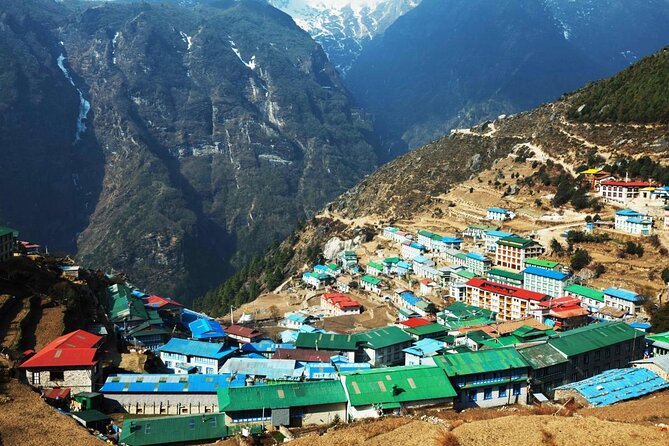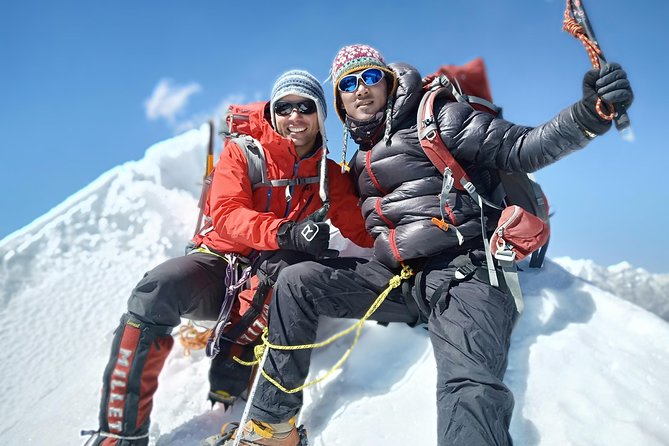Kyajo Ri Peak climbing presents a compelling challenge for those seeking adventure in the Himalayas, standing tall at 6,186 meters. The trek to base camp is just the beginning, as climbers need to acclimatize properly before attempting the summit. Along the way, they’ll encounter breathtaking landscapes and enjoy the rich Sherpa culture. However, the journey demands careful preparation and a solid understanding of what to expect. As climbers gear up for this stunning expedition, they’ll soon realize there’s more to consider than just the climb itself. What lies ahead could redefine their experience.
Good To Know

- Kyajo Ri Peak, at 6,186 meters, offers stunning views and challenging climbing experiences in the Himalayas near Kathmandu.
- The structured itinerary includes acclimatization, summit day, and cultural experiences, enhancing climbers’ safety and enjoyment.
- Essential inclusions cover meals, accommodations, guides, and insurance, ensuring a comprehensive climbing experience.
- Strong physical fitness and acclimatization are crucial for successful climbing; pregnant travelers should refrain from participation.
- Valid passports and personal insurance are necessary; additional costs for personal expenses and gratuities should be anticipated.
Overview of Kyajo Ri Peak

Kyajo Ri Peak, standing majestically at 6,186 meters, beckons adventure enthusiasts with its breathtaking views and challenging climbs. Nestled in the heart of the Himalayas near Kathmandu, this stunning peak offers a unique blend of natural beauty and exhilarating adventure.
With its striking ice formations and rugged terrain, climbers are treated to an unforgettable experience. The region around Kyajo Ri is rich in culture, featuring traditional Sherpa villages and ancient monasteries, which add a fascinating dimension to the journey.
While the climb demands physical fitness and determination, the rewards include awe-inspiring panoramas and a profound sense of achievement. For those seeking an exhilarating challenge, Kyajo Ri Peak stands as a beacon of adventure in Nepal’s majestic landscape.
You can also read our reviews of more tours and experiences in Kathmandu.
Climbing Itinerary and Schedule
Typically, climbers embark on a carefully crafted itinerary that ensures they acclimatize to the altitude while experiencing the stunning landscapes surrounding Kyajo Ri Peak. The schedule generally spans over several days, allowing participants to engage fully with their environment.
Here’s a typical itinerary breakdown:
-
Day 1: Arrival in Kathmandu and briefing on the climb.
-
Day 2: Trekking to the base camp, with stops to enjoy local culture.
-
Day 3: Acclimatization day at base camp, including light hikes.
-
Day 4: Summit day, starting early to reach the peak and descend.
This structured approach not only enhances safety but also enriches the climbing experience, making the journey both adventurous and rewarding.
Essential Inclusions for Climbers

For climbers gearing up for the adventure of a lifetime, understanding the essential inclusions can make all the difference in their experience. These inclusions ensure a well-rounded and enjoyable climb.
| Inclusion | Details |
|---|---|
| Meals | Three meals daily: Breakfast, Lunch, Dinner |
| Accommodation | Provided as per the itinerary |
| Guide & Porter | Professional guide and one porter per two climbers |
| Insurance | Personal climbing gear and insurance included |
With these essential inclusions, climbers can focus on the breathtaking views and physical challenges ahead, knowing their needs are well taken care of. Proper preparation sets the stage for an unforgettable adventure on Kyajo Ri Peak.
Meeting Points and Logistics
When embarking on the thrilling journey of Kyajo Ri Peak climbing, understanding the meeting points and logistics is essential for a smooth experience. Proper planning ensures climbers can focus on the adventure ahead.
Here are some key logistics to keep in mind:
-
Pickup Locations: Participants can choose from specified pickup points or meet directly in Kathmandu.
-
Start Time: The journey kicks off promptly at 07:00 am, so punctuality is crucial.
-
End Point: The activity concludes back at the original meeting point for convenience.
-
Documentation: A valid passport is required on travel day, with details needed during booking.
Health and Fitness Requirements
Understanding the health and fitness requirements for Kyajo Ri Peak climbing is vital for ensuring a successful and enjoyable adventure. Climbers need a strong physical fitness level, as the journey demands endurance and stamina.
Regular cardiovascular workouts, strength training, and hiking practice are essential for preparing the body for the challenges ahead. It’s not recommended for pregnant travelers due to the strenuous nature of the climb.
Plus, acclimatization to high altitudes is crucial; climbers should allow time for their bodies to adjust. Staying hydrated and maintaining a balanced diet during training can further enhance performance.
Ultimately, being in peak physical condition significantly increases the chances of a rewarding and safe climbing experience on Kyajo Ri.
Accessibility Considerations
Accessibility considerations for Kyajo Ri Peak climbing are crucial for potential climbers to understand before embarking on this adventure.
This trek presents several challenges that climbers must be aware of:
-
Physical Fitness: A strong physical fitness level is essential for tackling the ascent.
-
Not Wheelchair Accessible: The rugged terrain and high-altitude conditions make the route unsuitable for wheelchair users.
-
Travel Restrictions: Pregnant travelers should avoid this climb due to its demanding nature.
-
Guided Experience: Hiring a professional guide is recommended to navigate the complex trails safely.
Important Documentation Needed
Typically, climbers need to ensure they’ve the right documentation before setting off for Kyajo Ri Peak. A valid passport is essential, and climbers must carry it on the travel day. When booking, passport details are also required, so it’s crucial to have this information handy.
Plus, it’s wise for climbers to secure personal travel insurance, covering any unexpected incidents during the expedition. This documentation not only aids in smooth travel but also ensures climbers comply with local regulations.
Lastly, participants should keep copies of all important documents, both physical and digital, to avoid any last-minute hassles. Proper documentation helps make the climbing experience enjoyable and worry-free, allowing climbers to focus on the adventure ahead.
Additional Costs and Considerations
Alongside the necessary documentation, climbers should be aware of additional costs and considerations that may arise during their journey to Kyajo Ri Peak.
These expenses can significantly impact the overall budget, so it’s essential to plan accordingly. Here are some key items to keep in mind:
-
Personal Expenses: Any costs for souvenirs, snacks, or other personal items aren’t included.
-
Tips: Gratuities for guides and porters are expected and should be factored into the budget.
-
Alcohol: Beverages aren’t part of the package, so climbers should budget for drinks.
-
Insurance: While personal climbing gear is covered, climbers should ensure they’ve adequate personal insurance for emergencies.
Being prepared for these costs can ensure a smoother climbing experience.
Frequently Asked Questions
What Is the Best Time of Year to Climb Kyajo Ri Peak?
The best time for climbing in Nepal typically falls between October and November, or March to April. During these months, climbers enjoy stable weather, clear skies, and moderate temperatures, enhancing their overall experience.
Are There Any Age Restrictions for Climbers?
There aren’t strict age restrictions for climbers, but participants should have a strong physical fitness level. Guides recommend that younger climbers have experience, while older climbers should consult their doctor before attempting challenging activities.
What Weather Conditions Can We Expect During the Climb?
During the climb, climbers can expect variable weather conditions, including cold temperatures, potential snowfall, and strong winds. It’s essential they prepare for sudden changes, ensuring they have appropriate gear and clothing for their journey.
Can I Rent Climbing Gear in Kathmandu?
In Kathmandu, climbers can easily rent climbing gear from various shops. These shops offer a range of equipment, ensuring climbers find what they need. It’s advisable to check the gear’s condition before renting.
Is Altitude Sickness a Concern on This Climb?
Altitude sickness is definitely a concern during high-altitude climbs. It affects individuals differently, so proper acclimatization and hydration are crucial. Signs include headaches and nausea, so awareness and preparation can help mitigate risks effectively.
The Sum Up
Kyajo Ri Peak climbing presents an unforgettable adventure for those seeking a thrilling challenge in the Himalayas. With its breathtaking landscapes and cultural richness, climbers gain more than just a summit—it’s a journey of personal growth and connection to nature. Proper preparation and understanding of the itinerary, health requirements, and logistics ensure a safe and rewarding experience. For anyone ready to embrace the heights and beauty of Kyajo Ri, this expedition promises memories that last a lifetime.
More Tour Reviews in Kathmandu
Not for you? Here's more nearby things to do in Kathmandu we have reviewed
- From Lukla: Everest Base Camp (EBC) 10-Day Trek
- Kathmandu : Everest Mountain Flight – with Private Transfers
- Full Day : Kathmandu Sightseeing By Bus Day Trip
- Kathmandu: 7 UNESCO World Heritage Sites Day Tour
- Kathmandu: 8-Day Langtang Valley Trek with Transfers
- Thamel Rickshaw Tour
- Everest View Motorbike Tour- 6 Days
- Kathmandu: Top 4 UNESCO Sites Private/Group Tour with Lunch
- From Oceans to Mountains-9 Days (Nepal Guided Tour)
- From Kathmandu: Everest Base Camp Helicopter Tour landings
- Kathmandu: Food and Drink Walking Tour
- Life and spirituality tour of Kathmandu
